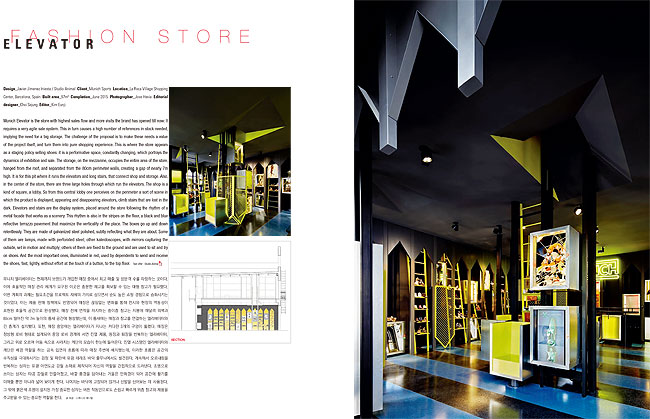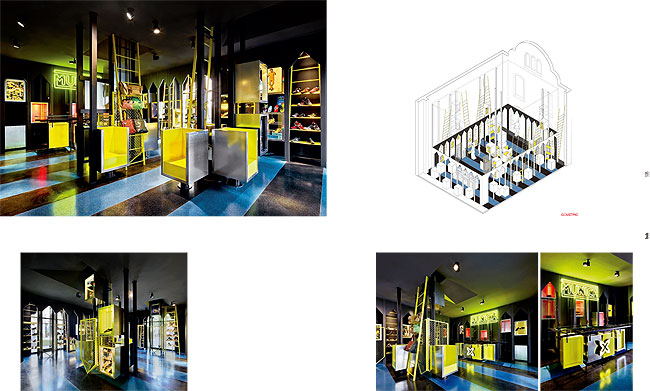ADEMIA OFFICE BUILDING & INDUSTRIAL WAREHOUSE
Architect: Joao Mendes Ribeiro with Catarina Fortuna & Joana Brandao



아데미아 사무실 건물과 보관창고 코임브라(Coimbra) 의 산업지대에 위치한 <아데미아 사무실 건물과 보관 창고>는 창고 공간과 사무시설, 상업구역을 결합한 두 동으로 이루어진다. 상대적으로 더 작은 2층 건물은 대지의 경계에 위치하여 주요 가로와 면해있다. 상업 공간은 출입 층에 있고, 사무실은 2층에 위치한다. 그보다 크고 긴 단층 건물은 창고로서 대지의 중앙에 위치하는데, 같은 크기의 유닛 다섯 개를 결합하고 그 위를 경사지붕으로 덮어 만들었다. 평지붕으로 덮인 2층 통로는 두 건물을 이으면서 지상의 안뜰이 내려다보이는 시야를 만든다. 선정된 재료들은 두 동의 성격을 특징짓는 데 주된 역할을 한다. 시공의 해법과 디테일은 이 두 건물의 형태적 정체 성을 이룬다. 하나의 수평선이 두 동을 가로 지르면서 두 가지의 핵심 재료, 즉 콘크리트와 회색도장 파형 강판을 분명하게 구분한다. 현장에서 타설한 콘크리트 벽체가 기초에서 솟아올라 이 수평선과 만난다. 거푸집이 그 위의 파형 강판과 모양이 같아서, 벽체의 상단에서 하단까지 연속적인 패턴을 만들어낸다. 수평선 위로는 개구부가 있는 지점까지 포함하여 입면 전체를 파형 강판으로 덮었다. 사무실 건물에서도 이와 비슷한 외장 시스템을 활용하여, 작은 구멍들을 낸 파형 강판 스크린들을 통합한다. 이런 해법은 두 동을 잇는 공중 통로의 한쪽 입면에도 적용되어 투명한 느낌을 자아낸다. 결국 이 두 재료를 프로젝트 전반에 일관되게 사용하고 창의적으로 결합 함으로써, 두 동이 하나의 전체로 작동하는 독특한 정체 성을 만들어낸다. 창고 내부에서는 유광 콘크리트 바닥을 쓰고 기계 전기 설비를 노출시켰으며, 지붕 구조와 콘크리트 벽체, 강재와 같은 구조 요소들을 벽면에 노출시켜 산업적인 분위기를 자아냈다. 창고동 내부에 금속 구조와 콘크리트 회색 패널로 지은 소규모의 중층은 직원 시설을 수용하면서 계단을 통해 공중 통로와 연결된다. 사무동은 바깥 지붕과 다르게 만든 경사 천장들로 구성한 다양한 실을 보여준다. 자작나무 합판과 가구, 그리고 석고보드 벽체가 이 공간을 나누고, 자체적으로 수평을 이루는 연속 모르타르 바닥을 통해 공간을 통합한다.
글: 주앙 멘데스 리베이로, 카트리나 포르투나, 조안나 브란당
Located in Coimbra’s industrial area, the [Ademia office building & storage warehouse] is made of two volumes combining warehouse space, office facilities and a commercial area. The smaller two storey building is located at the limit of the site and faces the main street. The commercial space is set at the entrance level with offices located on the first floor. A larger and longer one storey building (the warehouse) is located at the centre of the site and it is formed by a combination of five equally sized units with pitched roofs. A flat-roofed passage on the first floor connects the buildings, creating a view over the courtyard at street level. The selected materials play a major role in the characterization of the two volumes. Constructive solution and detailing become the formal identity of these buildings. A horizontal line runs across the two buildings, creating a clear distinction between two key materials: concrete and grey coated corrugated steel panels. A cast in-situ concrete wall emerges from the foundations level to meet this horizontal line. The cast i ng f rame has the same shape as the corrugated steel panels above it, creating a continuous pattern from the top to the bottom of the walls. Above the horizontal line, the entire facade surface is clad with corrugated steel places, including at points where there are openings. In the office building, a similar system for cladding was used integrating micro-perforated corrugated steel screens. This solution was also applied in one of the facades of the elevated passage between the buildings, which gives it a sense of transparency. Ultimately, the consistent use of these two materials throughout the project, and the inventive ways in which they are combined together, creates a unique identity for both buildings to act as a whole. Inside the warehouse an industrial atmosphere is achieved by the use of polished concrete flooring and exposed mechanical and electrical infrastructures as well as exposed constructive elements, such as the roof structure, concrete walls and steel on wall finishing. Inside the building a small mezzanine built with a metallic structure and concrete grey panels houses the staff facilities and links to the elevated passage via a staircase. The office building displays different rooms with lean-to ceiling that recreate the exterior roof. Birch plywood doors and furniture and plasterboard walls divide the space, where continuous self levelling mortar flooring is used to unite the space.
Written by Joao Mendes Ribeiro with Catarina Fortuna & Joana Brandao
이 프로젝트에서 금속을 주재료로 사용한 이유는 무엇이며, 사용된 금속의 종류와 그 특성에 대해 설명해달라. 우리는 두 동의 기초와 상층부 사이에 존재하는 차이를 강조하기 위해, 콘크리트 기초를 연상시키는 현장 타설 콘크리트 벽체를 설계했다. 상층부에서는 입면과 지붕에‘ 가벼운’ 재료를 쓰고 싶었기 때문에, 회색도장 파형강판을 선택했다. 콘크리트 타설 시에도 같은 강판을 사용했고, 콘크리트의 색과 비슷한 회색을 선택했다. 창고동에서는 벽체와 지붕 구조도 금속이기 때문에, 실내에는 또 다른 유형의 도장 파형 강판을 선택했다. 사무동에서도 지붕 구조는 금속이지만, 내부의 벽체는 석고로 마감했다. 2층에서 두 동을 잇는 평지붕의 통로는 긴 트러스 교량처럼 강재로만 만들었다. 금속을 다루는 건축물의 설계, 시공 과정의 주안점은 무엇이라고 생각하는가? 금속을 설계하고 시공할 때는, 조인트의 접합과 설계에 특히 신경 써야 한다. 금속과 같이 사용하기 좋은 재료는 어떤 것이 있으며, 어떤 시너지 효과가 있는가? 주로 단순한 기하형상을 활용하고, 부재들을 곧잘 필수 단위까지 잘라내며, 통일성을 추구하고, 최소한의 형태적 제스처로 긴장감을 극대화하고자 하며, 그 과정에서 재료는 엄밀하게 선택하고 시공하는 (그 중 많은 경우는 손수 만드는) 것이 우리 작업의 주된 특징이다. 어쨌든 이런 작업은 영역과의 관계와 더불어 어떤 형태적 엄밀성을 번역해내는데, 이는 포르투(Porto) 건축대학의 전통에서 매우 중시되는 개념들이다. 재료와 전통적인 건축 기법 및 구축체계와 깊이 연관된 건축을 위한 선택이야말로 사실 우리 작업의 기본 바탕이다. 이 프로젝트에서는 프로그램 때문에 콘크리트와 강재를 선택했지만, 콘크리트는 우리가 직접 ‘조형’했다. 연결성을 키우기 위해 강판을 거푸집으로 활용하면서 말이다. 또한, 목재와 석재처럼 많은 수공 재료나 천연 재료도 금속과 어울린다고 생각한다. 현재 주목하고 있는 재료는 어떤 것이며, 앞으로 주목 받을 재료는 무엇이라 생각하나? 앞서 말했듯이, 대개 우리가 우선적으로 선택하는 건 손수 만든 재료들이다. 그 이유는 아마도 우리가 개축과 재활성화, 복원 프로젝트를 많이 하기 때문일 것이다. 현재 유럽에서는 건물이나 도시, 혹은 영역을 재활성화하는 작업이 아주 흔해지고 있는데, 요즘에는 그게 신축보다 훨씬 더 합리적이기 때문이다.
인터뷰이: 주앙 멘데스 리베이로
Is there any particular reason for using Metal as main material for this project? And what types of Metal have you used in this project, and what general properties do they have? We intended to highlight the difference between the foundation and the upper parts of both buildings. We designed a cast in-situ concrete wall that evoked the concrete foundations. On the upper levels we wanted to use a “lighter” material for the facades and the roof, so we chose grey coated corrugated steel panels. The same panels were used to cast the concrete and we chose the colour grey to resemble the concrete. In the warehouse, the wall and roof structures are also metallic, so we chose another type of coated corrugated steel panels for the interior. In the office building, the roof structure is aldo metallic, but the wall finishes inside are made of plaster. A flat-roofed passage, that connects the buildings on the first floor, is entirely made of steel, like a long truss bridge. About what should we be careful when designing and undertaking construction with Metal? When designing and undertaking construction with metal we should be specially careful with the assembly and design of joints. What materials are good to be used with Metal, and what synergetic effects can occur by using them together? The use of simple geometrical shapes, the tendency to cut elements to the essential, the search for unity, the desire to achieve the utmost tension with the minimal formal gesture, associated to a rigorous construction process and choice of materials (many of them handmade), are the principal features of our work. Somehow, it translates a certain formal austerity together with the rapport with the territory, which are concepts that are very dear to the tradition of the Porto Architectural University (FAUP). The choice for an architecture which is deeply connected with the materials and the traditional building techniques and constructive systems is, in fact, the basis of our work. In this project, because of the program, we chose concrete and steel, but we “worked” the concrete, using the steel panels as casting frame, in order for them to be more connected. We also think that many handmade or natural materials, like wood and stone, go together with metal. What material are you looking at now? And do you think what material will get much attention in the future? As we said before, handmade materials are usually our first choice. That happens perhaps because we work in a lot of refurbishment, rehabilitation and restoration projects. In Europe, right now, to rehabilitate a building, city or territory is becoming very common, since nowadays it makes much more sense than building from scratch.
Interviewee: Joao Mendes Ribeiro
건축문화 2016년 4월호 [Monthly Issue]페이지 © 에이엔씨출판(주)